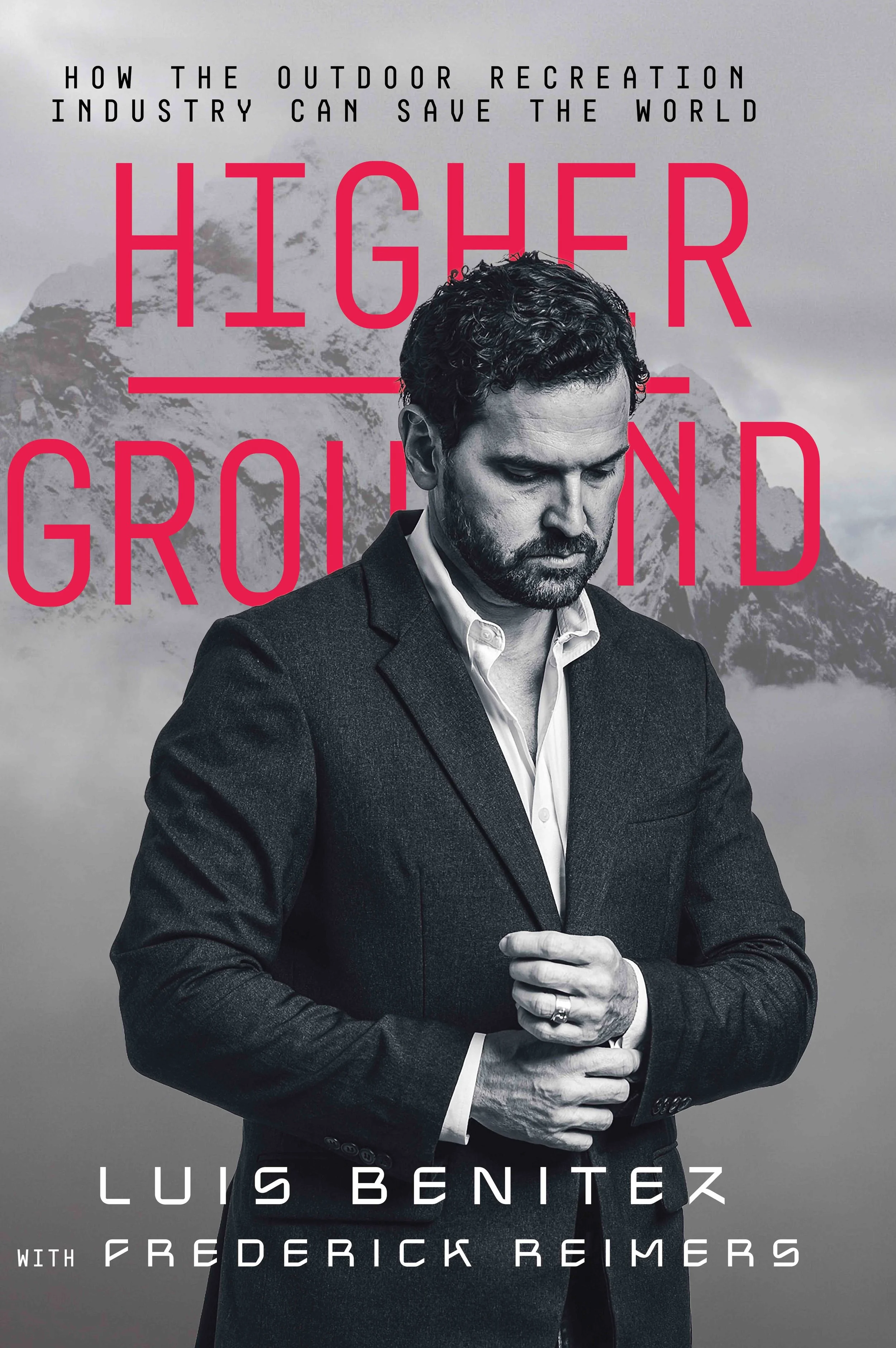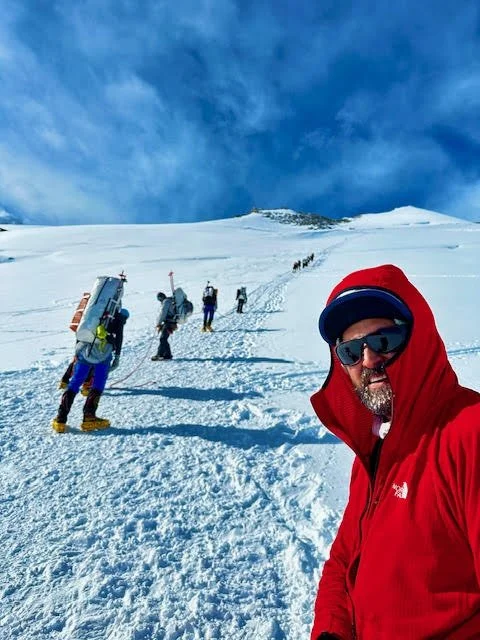‘Higher Ground’: Benitez makes the case for a national office of outdoor recreation in a compelling new autobiography
In one corner, you’ve got a Rockefeller, a Kennedy, an Udall and an Albright. Scattered around are some kings of industry from Standard Oil, Prudential Insurance and the Weyerhaeuser Company. And there are dozens of others from places like the U.S. Congress, the University of Michigan school of natural resources, the Izaak Walton League and even the New York Times.
And in the other? There is the son of an Ecuadorian immigrant, one who took his first steps in the outdoor world on the floor of his grandfather’s hunting shop in Missouri, one who overcame a childhood of asthma and inactivity to guide others to the world’s highest and most dangerous summits, one who was shoulder tapped to head up the Colorado Office of Outdoor Recreation when it was first formed in 2014, and one who has evolved into the leading voice of the modern outdoor recreation movement.
Both corners are making the same case – that this exact moment would be a damn smart time to deploy a national office of outdoor recreation. But while the all-star group of politicians and industrialists made their call a little more than decade after World War Two, the other is doing it right now in a new book “Higher Ground: How Outdoor Recreation Can Save the World,” by Luis Benitez and Frederick Reimers.
Despite the sizable age gap, the original idea for a national office of outdoor recreation was spurred by a series of events that sounds quite familiar – in the early years following a worldwide economic shutdown, there was a great redistribution of the population as they sought out new places to live, outdoor recreation soared in importance and awareness began to rise for our collective impact on the natural world. And so, recognizing that post-war prosperity was off to a bumpy start, a presidential panel was formed in 1958 known as the Outdoor Recreation Resources Review Commission.
That commission took four years to look at the entirety of outdoor recreation, to estimate its role and value both socially and economically, and to assess the threats of a booming and relocating population: “The demand is surging. Whatever the measuring …it is clear that Americans are seeking the outdoors as never before. And this is only a foretaste of what is to come. Not only will there be many more people, they will want to do more, and they will have more money and time to do it with. (In the near future) the population should double; the demand for recreation should triple.”
By the time of its completion in 1962, the commission had compiled some big evidence, like how an estimated 90 percent of Americans enjoyed some form of outdoor recreation each year, and that altogether it was worth around $20 billion a year. The commission also made a handful of hefty recommendations, including a call for ongoing funding for the outdoors (an idea which eventually blossomed into the Land and Water Conservation Fund), as well as the creation of a national office that could be both guardian and guide. That idea became the Bureau of Outdoor Recreation, which was propped up in 1963 and had a healthy run before being erased from the books during the Reagan administration of the 1980s, which culled just about anything with a whiff of green including removing the solar panels which the previous administration had built on top of the White House.
For sure, the view of outdoor recreation in 2024 is quite different. Outdoor recreation’s economic breadth has been measured to the teaspoon by the data nerds at the Bureau of Economic Analysis, and is currently worth more than $1 trillion to the US economy. It is a proven driver of public health, of conservation, of small business development, and of building bridges to underserved communities. And as big as it is already, there is a strong case to be made that there’s plenty of room for more growth. Americans live predominantly in cities now, farther from outdoor recreation resources, and only 50% of the country says they pursue outdoor recreation each year. That opportunity has been seen clearly by national policymakers who have unleashed multiple waves of federal funding for outdoor recreation – including parts of the Inflation Reduction Act, the Great American Outdoors Act and others. And they have done so with broad bipartisan support during the most partisan years in history.
As Benitez says early in “Higher Ground”: “The only thing both sides of the political aisle can agree on, seemingly, is funding and conservation for outdoor recreation. Those successes have led us to start asking whether it is time to push Washington, D.C., to create a federal outdoor-recreation-industry office to continue the promotion and preservation of this unique and special economy and ecosystem … outdoor recreation comprises nearly 2 perscent of our nation’s economy and provides priceless quality-of-life and health benefits to our people, but there’s no specific entity shepherding it in the federal government. Imagine how much more effective we could be with dedicated leadership?”
In making the case for a national outdoor recreation office, “Higher Ground” is one part case study and one part autobiography. Benitez’ inspirational personal story serves as the backbone for the most detailed and entertaining telling to date of the rise of modern outdoor recreation. Full of key data points as well as compelling anecdotes about its value and power, “Higher Ground” is well worth the time for outdoor recreation advocates of all shapes and sizes. But “Higher Ground,” is far more than an educational policy paper: it’s a compelling read capable of touching a far broader audience as well.
While painting a big picture and making a big ask is clearly the goal of the book (why else would the subtitle be “How the Outdoor Recreation Industry Can Save the World”), it’s the storytelling around Benitez’ life in the outdoors that is where “Higher Ground” moves from being pertinent to being a page turner. Those tales are wide ranging and intimately personal, including discovering his passion for climbing as a Missouri high schooler, early days guiding in the high altitude Andes, some poignant moments of racial awareness, and how he ended up at the heart of an international incident while climbing Cho Oyu. These are stories that will stick with you.
Benitez’ national profile first began to tick up in 2001 when he successfully guided blind climber Eric Weinheymer to the summit of Mt. Everest. A decade later, with little more than climbing guiding and ski instructing on his resume, Benitez successfully ran for local political office in Eagle, Colorado: a small success story that was widely passed around by ski bums and other mountain townies as proof that an outdoorsy resume could have a legitimate political voice.
In 2014, Benitez was shoulder-tapped by then-Governor John Hickelooper to head up a new Colorado Office of Outdoor Recreation, which at the time was one of just two in the country (the other being Utah, which launched in 2013.
In that same time frame, Outdoor Industry Association unveiled a groundbreaking set of data – a state-by-state estimate of outdoor recreation’s economic impact – that essentially weaponized outdoor recreation advocacy. It was announced in a small and lightly attended conference room of the Outdoor Retailer show, with a poster board for each state that showed a handful of stats attributable to outdoor recreation … including jobs, salaries and tax contributions … proving beyond a doubt the connection between outdoor recreation and local economies.
With an office of one and a budget of none, Benitez quickly set a high bar in the Colorado office. He seemed to be moving faster, smarter and with more energy than everybody else, racking up cool ideas and innovative programs with the same relish as a climber banging out personal first ascents. And then, a funny thing happened at the office that was tasked with leading the outdoor recreation sector in Colorado.
It started leading the country as well.
Benitez and Hickenlooper – who at the time was eyeing a run for the presidency – struck on an idea that would fortify Colorado at the forefront of the outdoor recreation movement, while also strengthening the tide behind it. Their idea was the creation of a guidebook, for lack of a better term, of major principles for all states to use and follow as they embarked on their state-level outdoor recreation initiatives. And their plan was to create this guide as a team effort, using the input and advice of all those other states to create the language, which in turn would guarantee their support of it.
That idea grew to become the Confluence Accords, a 2018 initiative that rallied all the state-level outdoor recreation efforts of the time – including Montana, North Carolina, Oregon, Utah, Vermont, Washington and Wyoming — to pool their best learnings into a surefire recipe of policy language. The effort took more than a year to complete, and was signed by each of the participating states. But, like most outdoorsy things, it was the journey that was the most valuable, as being invited by Benitez to participate in the Confluence process was a boost of energy for individual states looking to clarify their own thinking around outdoor recreation. It also cemented the novel idea that outdoor recreation was truly a rising tide, not a race.
In addition to going behind the scenes on Benitez’ role in the creation of Colorado’s state office and the Confluence Accords, “Higher Ground” also digs into his experiences during other formative events in the outdoor industry’s recent history, like the politically charged relocation of the Outdoor Retailer show from Salt Lake City to Denver.
Benitez happily shares the spotlight, though, as he recounts a laundry list of other local success stories led by other rising voices in the outdoor world. Like the story of Lucas St. Clair and the creation of Katahdin Woods & Waters National Monument; the brilliant creation and growth of Latino Outdoors by Jose Gonzalez; Janette Hueng’s groundbreaking study connecting public health outcomes to outdoor recreation; and Stacy Bare’s work using outdoor experiences to treat combat veterans with PTSD. Just to name a handful.
He also drops a variety of other compelling conversation starters in the book, like encouraging the emerging conversation around an outdoor tax of some sort to pay for recreational impacts, and highlighting some of his current work as Chief Impact Officer of the Trust for Public Land. And through all of it, explains the outdoor recreation economy in all its nuances with a writing style that is informative and relevant, a voice from the mountaintop that’s also right next to you.
One might say that in the same way the Confluence Accords provided a structure for state offices to follow, “Higher Ground” builds a structure for anyone else to follow as they strive to understand the heart and soul of the outdoor recreation economy.
One might also say that if the idea of a Bureau of Outdoor Recreation actually does get off the ground, the best candidate for leading a national effort around the outdoors would likely be the one who literally wrote the book on it.


